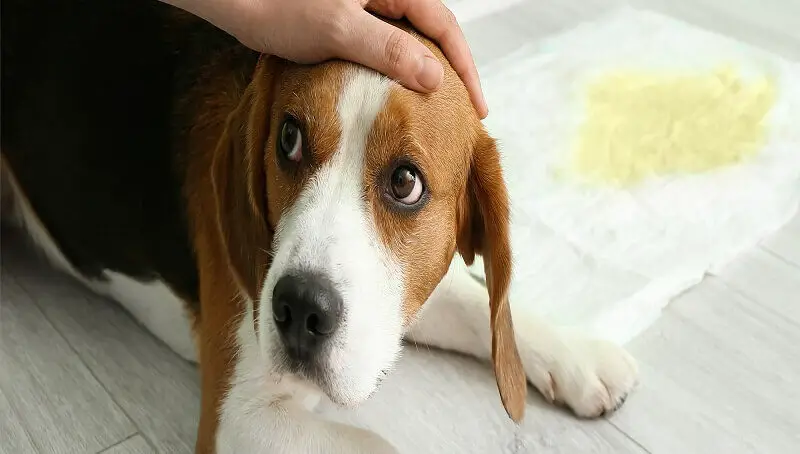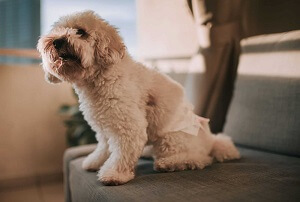
Do Bears Eat Humans? – Why do they attack?
January 27, 2023
How To Recognize And Treat Fleas In Cats
January 29, 2023
Urinary incontinence, urine leakage, is a common problem in older dogs, especially in females. Most likely the dog does not know when it is happening and cannot control the leaks, so do not scold him. This is a medical problem, not a behavior problem.
Lack of bladder control in any dog, young or old, male or female, is a problem. If there is something unusual in your dog’s urinary habits, for example, if he started urinating around the house, a trip to the vet is a good idea. Your veterinarian may be able to rule out some of the more serious conditions and provide viable treatment.
Why do Dogs have urine incontinence?
Urine leakage can be a symptom of a disease process or a consequence of aging. An examination by your veterinarian is aimed at checking for a urinary tract infection and other health conditions that could cause the leak.
Geriatric dogs
There are a number of reasons why older dogs may not have full control over their bladder. For example, the muscles that prevent urine leakage may be weakened or the dog may develop a disease that affects the bladder or urinary tract. In some dogs, congenital anomalies may not be revealed until the dog is old.
Older female dogs
You might also like my articles about:
- Reasons why dog’s urine smells like ammonia
- Why hasn’t my dog urinated for over 12 hours
- Why would a dog suddenly try to pee on you
One of the most common reasons for urinary incontinence occurs in older female dogs, often in medium and large breeds. It can be a function of both age and a state of health that requires veterinary attention.
In female dogs, the reproductory organs and urethra open in a common area called the vestibule. This area opens outwards and is called a vulva. As the dog ages, the muscles and sphincter of the bladder are not as toned as before and urine may leak a little into the area of the common vestibule.
When the dog gets up or stretches, a small amount of urine can be removed. This urine can lead to localized infections or climb into the bladder, causing a urinary tract infection that can further exacerbate the symptoms.
Hormonal causes
In sterilized females, this can also be caused by a lack of estrogen hormone. Your veterinarian may refer to this as incontinence that responds to estrogen. A lack of testosterone can cause this in male dogs as well.
Incontinence related to diseases
 In addition to losing muscle tone in the urogenital system, diseases such as diabetes or kidney disease often lead to increased thirst and urination. This exacerbates the accumulation of urine and the potential for a urinary tract infection.
In addition to losing muscle tone in the urogenital system, diseases such as diabetes or kidney disease often lead to increased thirst and urination. This exacerbates the accumulation of urine and the potential for a urinary tract infection.
Bladder infections, tumors, kidney stones, and cancer can cause incontinence in both male and female dogs, causing a sudden, uncontrolled urge to urinate. In some cases, urinary problems can even lead to a diagnosis of spinal cord disease, as nerve impulses to the bladder may be affected. Many of these diseases will have additional symptoms in addition to urine leakage, and may also be present without the symptom of incontinence. Only a veterinarian can determine the cause.
Diagnostic
Schedule an appointment with your veterinarian for a physical exam, no matter what you think may be the cause of the incontinence. Your veterinarian will check your dog’s urine and blood to make sure there are no other problems or diseases to treat. Additional screening and diagnostic tests may be needed.
Treatment
The good news is that the condition of a dog that has uncontrolled urine leakage usually improves with proper treatment. What this strategy entails depends on the cause of incontinence. It is not an emergency in most cases, but if your dog shows signs of illness, contact your veterinarian immediately.
Treatment for simple incontinence
If your dog has a “simple” incontinence problem, you may manage it with medication. For example, a urinary tract infection or bladder infection will likely be treated with antibiotics that will eliminate both infection and leakage. Phenylpropanolamine is a common option to treat hormone-responsive incontinence and can help increase muscle tone, improving your dog’s ability to control urine again. Collagen injections are also becoming a more popular option to help prevent incontinence in dogs.
Another option is to provide hormonal support to female dogs with a hormonal-based medicine. This increases her estrogen levels, which naturally increases the muscle tone of the urinary tract while resting.
Dealing with more complicated causes
For other causes of incontinence, your veterinarian will likely start treating the primary disease or medical condition. If the cause is bladder stones or an anatomical abnormality, surgery may be recommended. For other conditions, such as diabetes, the disease will likely be treated with medication and this can help solve the problem of incontinence.
How to prevent incontinence in dogs
While incontinence cannot be completely prevented, there are steps you can take to help your dog avoid or manage it.
- Let your dog urinate often. An empty bladder is much less likely to leak.
- Train your dog to sleep and lie down only on easy-to-clean surfaces in the house, or provide waterproof pads for puppies in your dog’s favorite places.
- Consider diapers for dogs, especially when you are not at home.
- Clean the dog properly to prevent any infection.
- Most importantly, don’t punish your dog. Keep in mind that it’s not his fault and it’s simply a part of the aging process for many dogs.
Final words!
It can be inconvenient for you sometimes, but it’s one of the things you know you have to deal with when you let your furry friend be part of your life.
